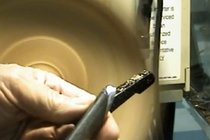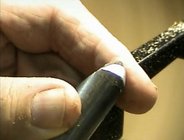We progress from coarse tools to remove large amounts of wood, to finer in a process of refinement, starting with chainsaw and ending with 600 grit paper (or your chosen endpoint).
For most of us, achieving a single curve, rim to rim, or a flat bottom without deviation with a gouge is near impossible. I keep working toward that goal, but is more aspirational than realistic at this point.
So, going to the next tool, less wood removed, but with greater control, a NRS. With it, you can remove wood just where needed. No requirement to start here and end there. Small sections can be addressed.
Then the problem becomes about your sensitivity. You can’t fix it if you don’t notice it. So, use that raking light while turning. Do your best to really tune in. Use the scraper till the surface is a flat and smooth as can be done with that tool. Then go finer, to sandpaper. I sand holding paper, and also power sand, first hand held, then power, same grit. I would start with 120. Your fingers are great at feeling some of the undulations, and the power sanding (mostly perpendicular to hand held) will help show the low spots. Keep doing this through grits, always working toward smoother and flatter.
You have the tools already, and you know how to use them. So, just like refining the surface, you need to work on constant refinement of your eyes, fingers and head.
Also, don’t do flat bottoms (also applies to the exterior). Curves are more attractive and a bit easier to deal with.
Marc


